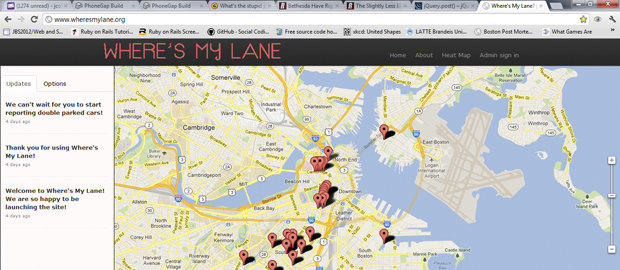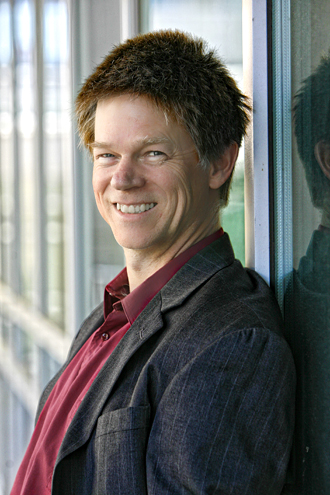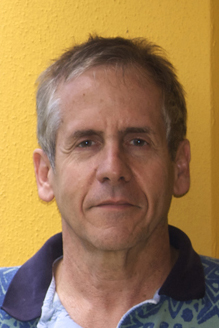App creators focus on cycling, gaming, service
JBS students design and deploy mobile apps and social media sites

Whether you’re looking for a job, connecting with friends or following breaking news, mobile applications and social networks have become ubiquitous around the world. And with the increase in users has come an ever-increasing demand for application designers and developers.
Now in its third year, the 10-week Justice Brandeis Semester (JBS) Web Applications and Social Networks program delves into the technical aspects of how to create a mobile app and a database-backed website ready to handle hundreds of millions of records. It also teaches the practice of computer science and software entrepreneurship.
“Students complete this program with a deep understanding of the architecture of web applications and social networking as well as the ability to design, develop, test, analyze and deploy them,” says Timothy Hickey, professor of computer science. “By the end of the course they not only know the theory, they are confident in their abilities to put those theories into practice.”
The course is offered to both undergraduate and graduate students at Brandeis who have completed one year of computer science.
This summer, 11 students produced two social media websites and two mobile apps. They recently presented their work at the Justice Brandeis Product Showcase to a full house that included Dave Cancel, chief product officer of HubSpot, a marketing software company; Dana Conroy from the Boston mayor's Office of New Urban Mechanics; Boston Globe columnist Scott Kirsner; Ted Morgan, founder and CEO of Skyhook, a location positioning technology firm, and Glenn McDonald, user interface designer at Echo Nest, a music intelligence platform company.
Student products included “WikiWitness,” a Wikipedia type platform for first-person accounts of historical events; “Where’s My Lane?” a mobile app for cyclists to report double parked cars to Boston city officials; “Volunteer Hours,” a web application that helps community service organizations create events, promote them and track volunteer hours; and “Spy Game,” an outdoor hide-and-seek game that transforms a cell phone into a tracking tool.
 |
|
| Professor Tim Hickey |
WikiWitness
WikiWitness was designed to be a Wikipedia-type portal to house first-person accounts of historical events from both the past and present. The idea, says Hickey, is that if someone was in Tahrir Square during Egypt’s elections, for example, or attended Martin Luther King Jr.’s “I have a Dream” speech, they could document the experiences. The site would allow others to read those accounts, pull out the most moving lines as a snippit, then recommend and share their favorite stories. An open-source design allows designers to improve and collaborate with back-end infrastructure— in other words, the programming code is available for others to improve upon.
“This is a fantastic way to let people get their own voice on record, says Pito Salas, a Boston-based entrepreneur and adjunct professor who co-teachers the course with Hickey. “You’re collecting controversial, maybe provocative, first- person accounts of events.”
The creators, Kendall McCarthy (Post-Bach MA) and Mustapha Isa ’14, say most people rely on the large media oligopolies to answer questions, but WikiWitness represents an alternative: a centralized repository for first-person accounts.
Volunteer Hours
Volunteer Hours is a web application that helps community service organizations create events, promote them and track volunteer hours. Volunteers have an
online profile page, which acts as a portal to store
all of their community
service activities. Developers Fatima Abudeeb (Post-Bach MA) and Avishek Neupane ’14 envision the site to act as a “Linked In” for community service organizers.
Where’s My Lane
Where's My Lane is a mobile application that enables bicyclists in Boston to report locations of illegally parked cars with the tap of a button on their smart phone. The locations are then tagged and sent to a server, which stores the data so it can be used by the city to effect policy and planning.
The collaboration between Brandeis and the city of Boston came about when Salas connected with a member of the Office for New Urban Mechanics.
“The world of civic hacking is really hot right now,” says Salas. “Bringing technology into government is happening at the federal, state and local level. Getting Brandeis on the map in that space would be fantastic.”
The need for “Where’s My Lane” was expressed by the bicycling community, who often encountered double-parked cars that interfered with bike safety.
“Over the course of the past few months I’ve learned that I am extremely passionate about making change through the use of technology,” says Rachel Burkhoff ’14, one of the app developers. “It’s crazy to think that something I created will help in so many ways. This process has truly helped me see how exciting it can be to make change happen myself.”
Other team members include Jeremy Coffman ’15 and Sam Beller ‘14.
Spy Game
Spy Game is an action game where players use their iPhone or Android as a “spy tool” to track down and capture other players. Founders— Eitan Mosenkis ’12, Ezra Skolnik ’14, Shu Lin Chan ’14 and Tom Ma ’14 say they chose to set their game in the real world in order to promote physical activity and personal interaction.
“In the game, one person acts as an international intelligence double agent who is about to leave the country with sensitive information,” says Skolnik. “The rest of the agents must track them down. They can see they spy’s relative positions on a map through a GPS system, but location is only displayed every minute, so actually catching him is not as simple as following his marker.”
 |
|
| Adjunct Professor Pito Salas |
Salas acknowledged that in a some cases, similar products to a few of those created during the JBS already exist on the market in some fashion, but, he said, “If you get discouraged because someone else has done something before, you may as well not get out of bed in the morning. Nothing has not been done before; you can always do it better, you can always change the spin you can always succeed where others have failed.”
Students participating in the Justice Brandeis Semester in computer science work from 10 a.m. to 4 p.m. taking three simultaneous courses; one is on web application design, another on social networks and the third is the incubator, where they come up with their idea, implement it, launch and reach out for customers.
The Justice Brandeis Semester, which is offered in a number of fields, is an engaging, immersive academic program in which small groups of students explore a thematic topic through inquiry-based courses linked to real-world experiential opportunities.
An important part of the Web Applications and Social Networks program involves learning and applying lean startup techniques — doing surveys, finding customers, making paper prototypes, revisiting the user interface based on feedback — to make sure the product is something people want.
Hickey and Salas say the students are not only learning the social aspects of working in a team, but also about the latest technology available, like software collaboration tools such as Agile Methodology, Pivotal Tracker, github and Heroku, a cloud application which allows developers to creative an interactive website then launch it on to the web.
“In the process of the course the students gain a superpower,” says Hickey. “To be able to imagine a web and mobile site, know how to create it and be able to get it out to the public.”
Categories: Business, Research, Science and Technology, Student Life





